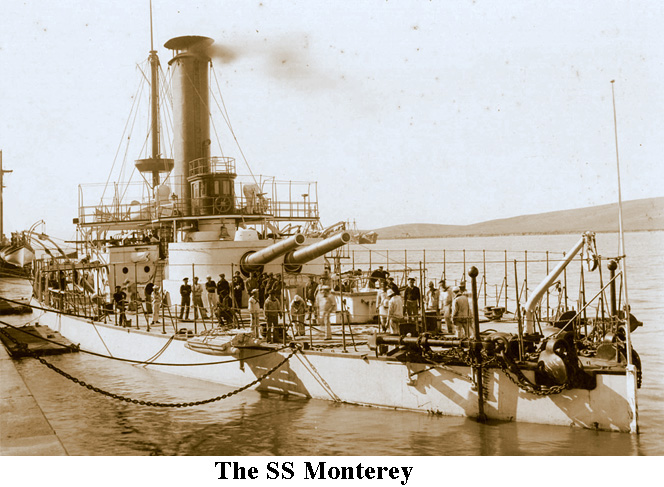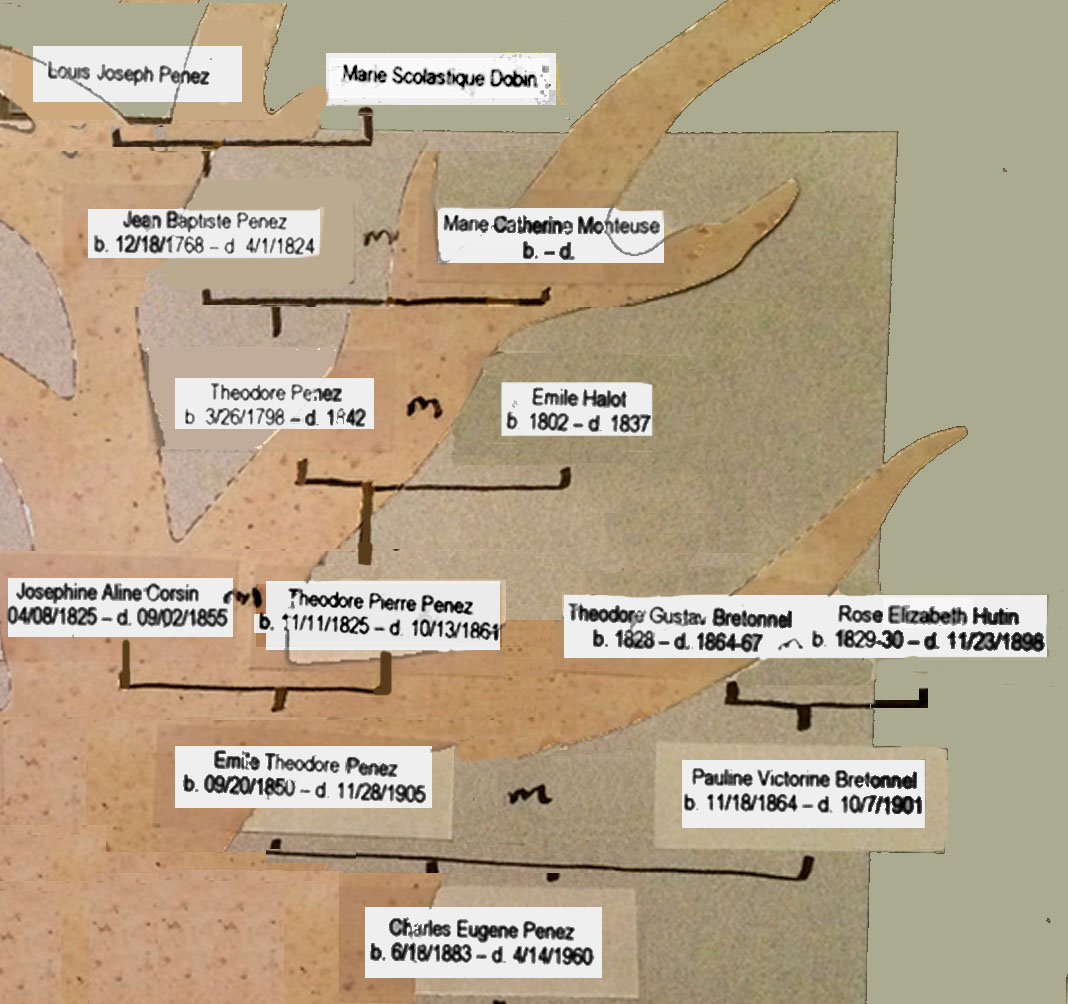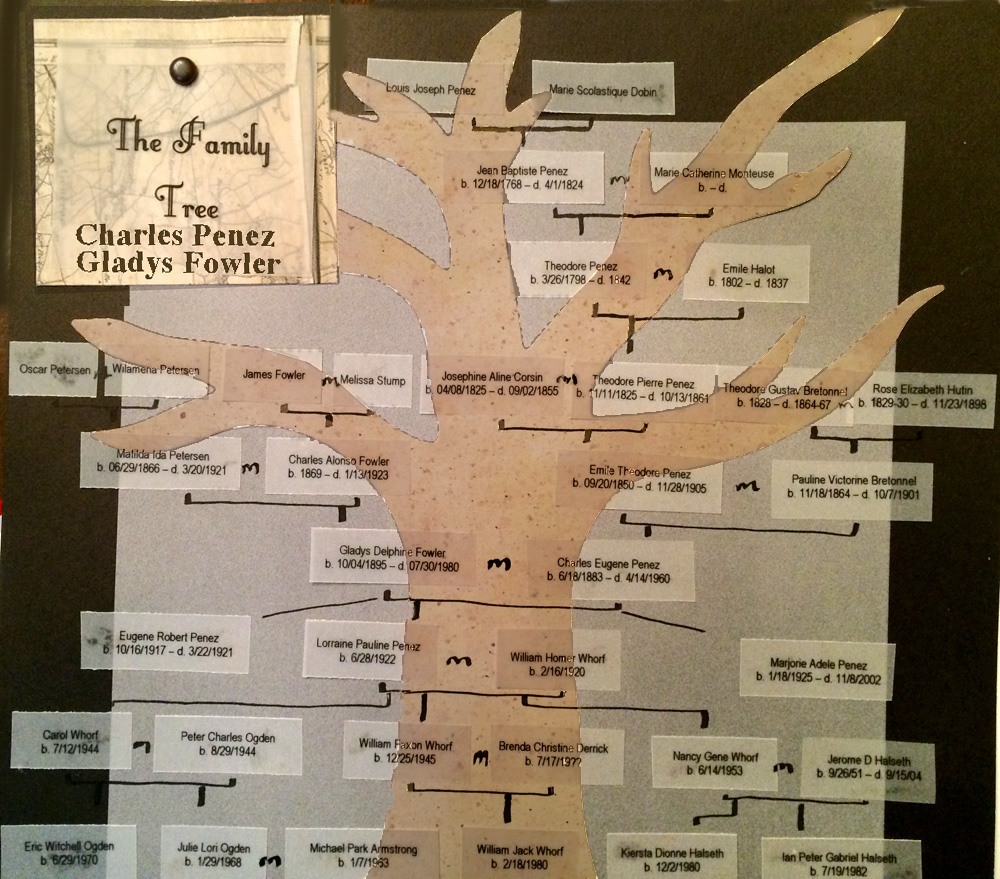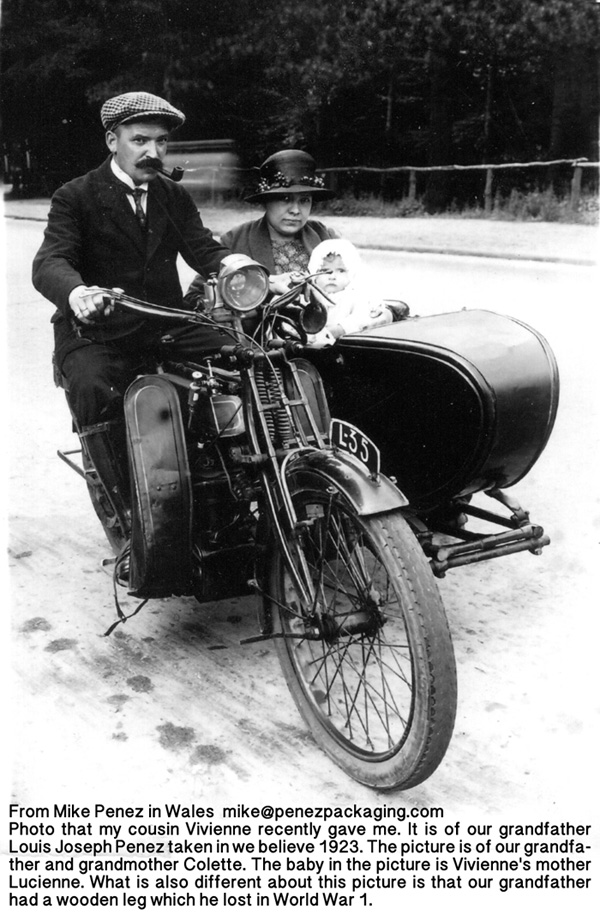 |
|||||
Penez Family History by Yvonne Penez Hawley, 1975 |
|||||
(I) The Earliest Records {Family tree from Lorraine »} |
|||||
|
|||||
~~ 1740 ~ Louis Joseph Penez ~~ According to family legend, Louis Joseph Penez left Saragossa, Spain, and migrated to France at the time of the Spanish Inquisition. This is all we know. This Louis, a shadowy figure at the tip of the family tree, invites speculation why? and when? There are hints in the record that suggest answers, and a framework of the times offers reasons. The two questions are really intertwined. The Inquisition in Spain lasted from 1478 to 1834. At first it was aimed at the Jews. By the Edict of 1492, the Jews were expelled from Spain unless they embraced the Roman Catholic faith. In 1502 Islam was eliminated via the same choice. The few Protestants that infiltrated the Spanish peninsula were likewise treated. From 1523 to 1834 any residents of now Catholic Spain were subject to the rigors of Inquisition--any layman, priest, and even bishop. Now, when did Louis Joseph Penez leave Spain? According to the family records we know that Louis married Marie Scolastique Dobin and had a son, Jean Baptiste Penez in Bethune, France (or maybe Bethune was a part of Belgium, or Flanders at that tine). The son was born on December 18, 1768. Assuming that Louis was an adult when he left Spain, we can allow about 20 years (a generation) and add some years for him to work his way from Saragossa to Bethune, to marry, and to beget a son; perhaps one may guess that he migrated to France some time in the 1740's. Why? Obviously religious reasons are suggested, yet his progeny do not demonstrate strong religious interests. They appear industrious, independent people, realistic and talented. Perhaps Spain would be stifling to such free spirits in the early 18th century. The Penez story, as it unfolds, as we learn more about the places, the interests, the activities of these people, indicates a vigorous individualism that does not rest easy in containment. ~~ 1768 ~ Jean Baptiste Penez ~~
~~ 1798 ~ Theodore Penez ~~ Of Theodore Penez we know very little more. He was born in Rouen, France, on March 26, 1798. He was employed in "construction" which could mean any part of the building trades. Evidently he moved about, at age twenty-six he married Emilie Halot in Lisieux, France, on November 8, 1824, and a year later, 1825, had a son, Theodore Pierre, in Fougeres, France. However, we do not have any record of where or when he died. ~~ 1825 ~ Theodore Pierre Penez ~~ 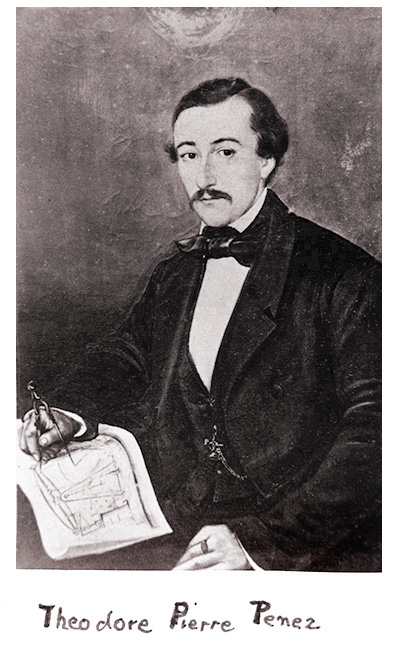
On the other hand, there is considerable information of Theodore Pierre Penez. Born in Fougers, France, on November 11, 1825, he grew to manhood, following his father in the construction industry and became a "master founder" (metal worker). We have a picture of him from a portrait which is probably still in France. A study of this portrait suggests that he advanced considerably in his field and shows us something of the kind of person he was. An intelligent, sensitive face, poised dignity, his attire sober but elegant, a golden watch-fob at his vest, jeweled ring on his left hand--these reveal a man of consequence. But most striking is his right hand--supple and controlled--holding a compass to a construction plan, possibly of a pump or derrick; the implication is that he was an engineer in metal construction. Theodore Pierre lived only thirty-six years; he died on October 13, 1861, in Valenciennes, France. At age twenty-four Theodore Pierre married Josephine Aline Corsun May 1, 1849. They had three children: Emile Theodore, Zelma, and Hortense. The mother died shortly thereafter (September 2, 1855) and little more than a month later, (October 16, 1855) Theodore married Julie Deforge by whom he had three more children: Celine Elisa, Charles Theodore, and Alexander Pierre. The second wife, Julie Deforge, apparently was a good mother to all Theodore's children. She was much loved by Emile who had her picture with him among his effects, and there was a closeness between Emile and his half-sister and half-brothers, especially with his half-sister Celine. The two families of Theodore Pierre prospered, as you can see by the accompanying chart. It is through Emile, the eldest, that we in America are descendants. That is the next story. |
|||||
(II) Emile, The "Family Celebrity" |
|||||
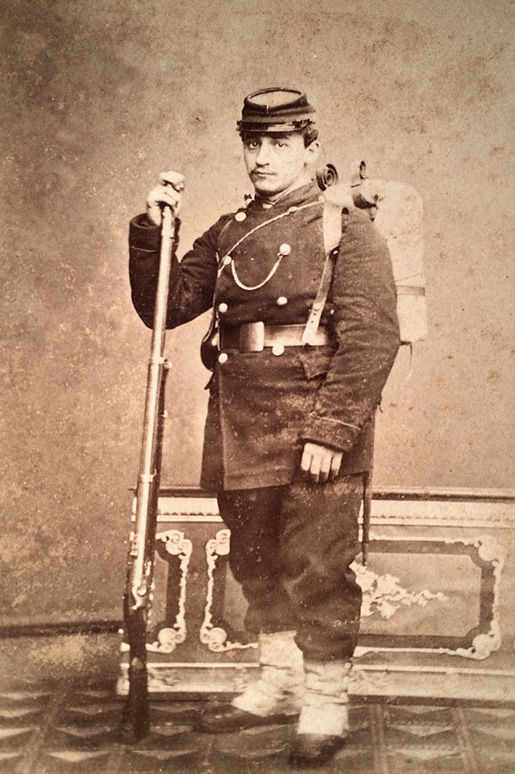 French Army Uniform - Franco Prussian War 1870 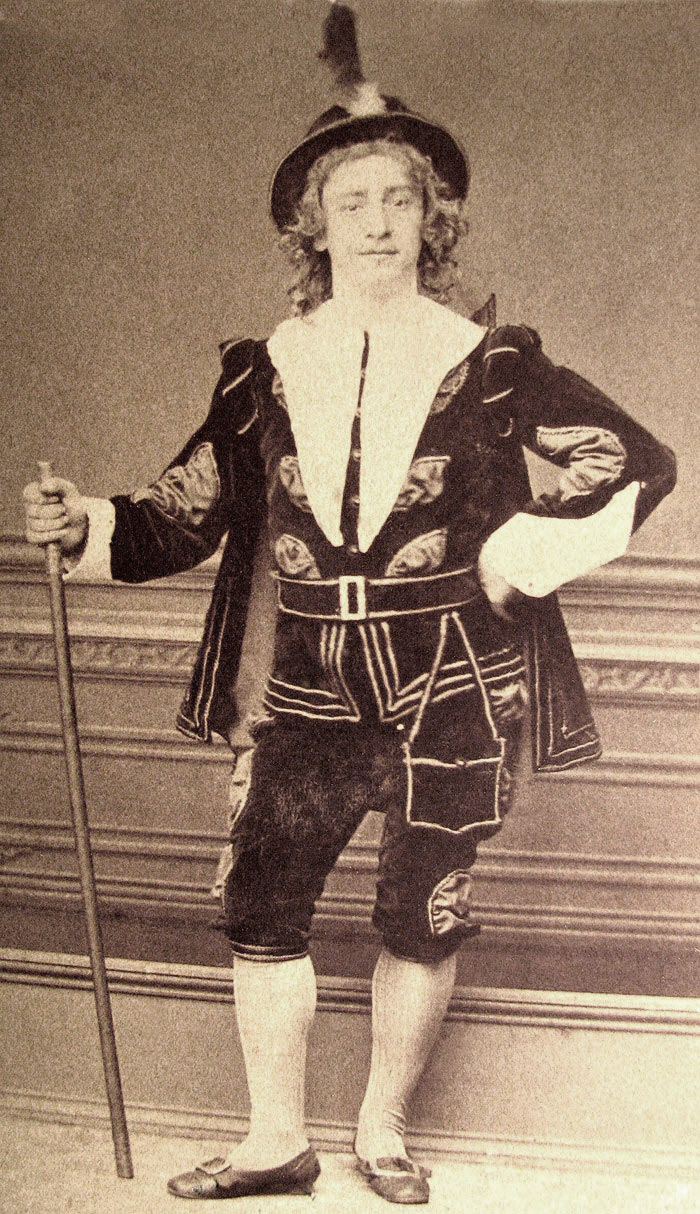 IN SANTIAGO, CHILE 1875 |
|||||
~~ Emile Theodore Penez ~~ Of Emile Theodore Penez (my grandfather) a wealth of evidence illuminates a life of adventure, romance, and solid accomplishment. There are press notices that follow him from Europe to America; there are numerous beautiful oil paintings, many of which we still have in the family; there are mementoes and legends of his exploits; there are photographs of his colorful performances in the theater; and there are records of his achievements as a designer in steel construction. Born in Valenciennes, France, in 1850, Emile spent his early years in Brussels, Belgium, then migrated to San Francisco, California, where he lived until his death in 1904. I never knew Emile, as he died three years before I was born [1907]; yet his story as cherished in the Penez family is a legend of romance. There is ample documentation, which consists at ~~ 1850 ~ Europe ~~ Emile was born April 25, 1850. (Date established in obituary notice in San Francisco Chronicle, Nov. 1, 1904) Two sisters followed: Zelma (January 20, 1862), and Hortense (September 15, 1853). Unfortunately the mother died shortly thereafter (July 2, 1855). Emile was almost five years old. His father remarried to Julie De Forge (October 16, 1855) by whom there were three children: Celine Elisa (September 1, 1856), Charles Theodore (April 22, 1858), and Alexander Pierre (January 8, 1860). A year and a half later the father died (October 13, 1861). This information is from a cousin: Felix Guillon of Brussels, a son of Celine Elisa. During the next several years Emile began to develop his musical talents. By the middle of 1873 he appeared in a concert at the Royal Society of Music Lovers as a singer of comic songs, an interest he pursued for the rest of his life. He also was on the program of the Institute Saint Louis in Brussels, presenting a chansonette. It may be that during this period he was a student at the University of Brussels. Under a M.D. Pottier, Emile presented a comic scene entitled "Les Garcons Boulangers" (The Baker Boys). It may be that M. Pottier was his instructor. The program was presented in the Salle de la Nouvelle in Brussels --a musical soiree offered by Belgian students of the Universite Libre de Brussels, (January 24, 1874). ~~ One of Emile's most romantic adventures, according to family tradition, started in Paris, where he was living in 1875. A fellow member of the starving artists' colony had given him an invitation to the big "Artists' Ball" there and Emile won the grand prize, which was a one-way ticket to the New World! Being a young bachelor, free and eager to find adventure, and having nothing to hold him back, Emile sailed off to America. ~~ 1875 ~ The New World~~ A press clipping dated May 16, 1875 lists Emile Penez appearing in a four act comedy: Les Inutiles (The Bums) at the Theatre de la Victoria in Buenos Aires, Argentina. There is no record of when he arrived, but he remained in Buenos Aires until August of that year. Family tales reveal that Emile was stranded there. In order to survive he went to a restaurant where he offered to sing for his supper, literally. His offer was accepted, and he was such a hit that the restaurant owner offered him a steady job as entertainer. To round out his income, Emile would paint portraits, landscapes, and seascapes on the quay of this foreign town and would sell them to the passers-by. Once Emile saw a man who had a beautiful meerschaum pipe that he wanted very badly, and he exchanged one of his paintings for it. Late in 1875 Emile managed to gain passage "round the Horn" to By now Emile had developed an imposing repertoire of theatrical performances both musical and histrionic: evidence, his character portraits taken in Santiago, Chile. These activities remained among his lifetime interests. The main body of his work in Santiago shows serious acting and early comic characterizations; the latter became his prime forte as the years followed. Emile remained in Santiago about two years. The performance dates in Chile are somewhat confusing. There is a clipping, "Balivernes" (Wise-cracks), dated August 19, 1875, which includes a line written by Emile. He was quite active during 1876. His debut is reported in June, with a troupe of entertainers called "Les Boulangers" (The Bakers). Emile sang two songs: "Les Veilles Filles" (The Old Girls), and "Le Carillonneur" (The Bell Ringer) by Beranger, a witty and very popular French lyric writer. Emile also appeared with this troupe in Valparaiso, Chile. As the story goes, early in 1877, yellow fever became epidemic in Santiago. To escape, Emile stowed away on a cruise ship -- the destination uncertain. Upon being discovered aboard, he proceeded to entertain the passengers with some of his comic songs. This so enchanted the "first class" voyagers that his passage was paid, and Emile birthed among them, entertaining them the remainder of the voyage. The ship's destination proved to be San Francisco, California. Emile remained for the rest of his life In San Francisco. Here are some additional character photos from his time in Santiago, Chile:
Larger version of these 1875 Santiago Photos »» Photos~~ 1878 ~ San Francisco ~~ In all quarters of the globe, the French expatriates often would clique together. San Francisco was no exception. Upon arrival in this city, Emile was embraced by the French colony. He was then directed to the French counsel to find employment and was recommended to Prescott, Scott, & Co. This was a fortuitous suggestion, and Emile Penez appears in the San Francisco City Directory (1878) as draftsman for that firm, a natural selection as his skill in drawing indicates. Two years later this ship building company was re-named The Union Iron Works. [By 1883 Shipbuilding was the main activity, replacing railroad engines & equipment] Emile remained with this firm until his death in 1904, having served his employers faithfully in a variety of services, as I shall describe later. 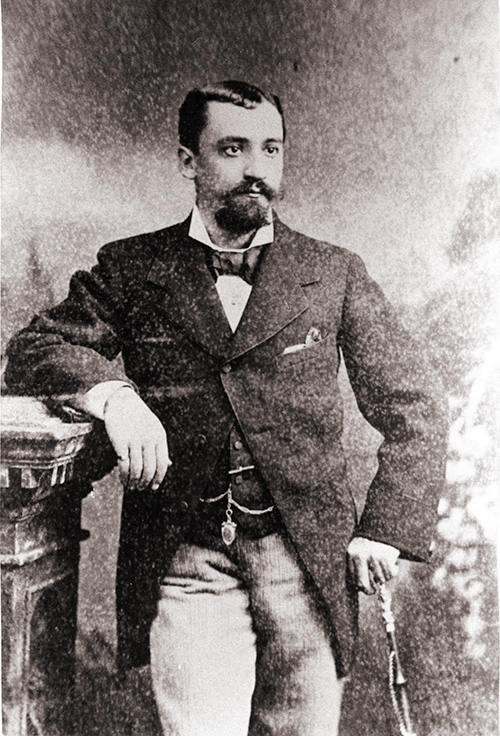
Return to Emile's early days in San Francisco, California, (1877): he was now approximately twenty-seven years old. He had survived a war (The Franco Prussian War 1870-71). He had adventured to the Americas and had made his way from Argentina to California with the aid of natural enterprise, luck, and ingenuity. He had by now developed his talents in painting and theater to a mature level. Aboard ship en route to San Francisco, Emile had met M. and Mme. Berland and their eight-year-old daughter Helene. The family was traveling as a theatrical troupe, one of skill and reputation. Emile joined with amateur artists of the French colony of San Francisco in presenting a benefit program for the Berland family on May 31, 1877. The Berlands appeared in Le Baiser de l'Etrier (The Kiss of The Stirrup). At intermission Emile joined the show with two of his comic songs: "Les Vielles Filles" (The Old Girls) and "Les Cheveux de ma Femme" (My Wife's Hair): This was probably Emile's debut in San Francisco; he was well received. The press report states that "the songs were delivered with a spirit that deserved the honor of being warmly applauded"; he was twice recalled by the Audience. Mid 1877 finds Emile all established in the city. His residence was listed as 77 Natoma St. His employment by Prescott, Scott, & Co., gave him stability, and he now enthusiastically entered into the social activities of this young city. He appeared before the Literary Social Society in Kessling's Ball, located at Howard Street and 21st Street, where he presented a character song. He also appeared as Peterman, a domestic, in: "M. Choufleury Restera Chez Lui"? (Will Mr. Choufleury (Cauliflower) be at home?) at another gathering for the benefit of Madmoiselle Singer. In other appearances Emile established his skill at Characterizations in presenting the roles of a laborer, a drunkard, a do-nothing, a roisterer, a gold-bricker -- most of these with the emphasis on comedy. Within three years, 1880, Emile Penez was secure as a top entertainer, much in demand at soirees, benefits, patriotic fetes, and stage presentations in the French colony. He appeared in a program before the Philarmonic Society Francais (November 1879) and with L' Orpheon Francais, (March 1880), at Platt's Hall. He added new songs to his repertoire, such as, "Je N'ai Pas Ose," (I Didn't Dare), "Les Peches de Jeunesse" (The Sins of the Young), "Un Amour d'Epicier" (A Grocer's Love), and "Le Carrillonneur" (The Bell-ringer), the latter written by Beranger, one of Emile's favorite sources for material at this time. Reviews of Emile's performances from the local press (primarily Le Franco-Californien) translate: "bursts of applause and prolonged bravos" ... "delightful rendition of French comic songs" ... "knows how to make his point"..."outdid himself"..."the voice, the physique, the gestures... these joys... these successes; he makes one laugh continuously"..."side-splitting" ... "a singer and a comic who can put his public in a gay mood"..."reached a pyramid of success...recalled four times"..."brought down the house!" ~~ 1880 ~ Romance ~~ 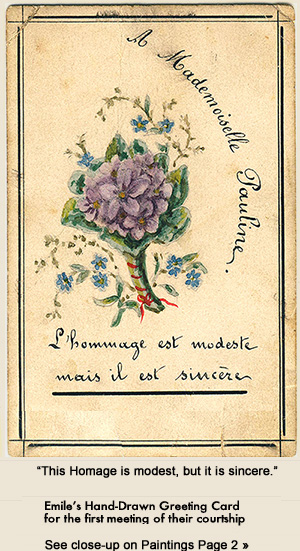
In April 1880 Emile attended a surprise party for a Miss Alice Lalande. Among the guests was the Bretonnel family, and a Miss Pauline among them. It is doubtful that Emile met the young lady at this time, as she was much too young. There were yet two years ahead when Miss Pauline would make her debut. Her brother Alfred, however, may have become acquainted with Emile then or within the following two years as Alfred, his brother Jules and Emile, are all listed in press clippings as being present at various entertainments enjoyed by the French colony. On Friday evening, February 17, 1882, Emile and Jules attended one of the numerous soirees that brought the French together in this little city that was so far away from their homeland. The entertainment that evening was provided by the students of Signorina Adelina Speranza, Teacher of "The Institute" (which institute is not indicated in the press clipping). The fourth number is listed as "Melodia" (Le Prentemps by Gounod is indicated in Emile's script) and sung by Miss P. Bretonnel. Emile was enchanted. He pressed for silence from his friend. As "Melodia" came to its end, he solemnly announced that his future bride had just left the stage. Jules, incredulous, protested that he must be dreaming, adding, "Do you realize that you are speaking of my sister!" But it was to be. Scarcely three months later, on the 20th of May, 1882, Pauline and Emile were married in the little French Church, Notre Dame des Victoires, by Abbe Pierre Robert. ~~ 1882 ~ Marriage ~~ The story of Emile and Pauline's married life together is obscure. It lasted but little over five years. May 1882--July 1887. There are no existing records of this period regarding their personal relationship. On June 18, 1883, their son Charles Eugene Penez was born. Only Charles's stories and his memories enlighten this time. Emile's scrap book, which contains most of the information about his life is silent except for a very few notices from these years. From the evening, Feb 17, when Pauline sang at her debut until the marriage date on May 20, there are no notices of parties or performances. One may guess that Emile was occupied with his suit for her hand. A touching, beautiful little memento remains of this time, Emile's calling card decorated with a bouquet of violets and forget-me-nots in water color on the reverse side. The message: "A Mademoiselle Pauline ... L'hommage est modeste mais il est sincere" suggests an offering of flowers, perhaps even violets. This lovely gesture survived the years, so someone cared enough to save it. 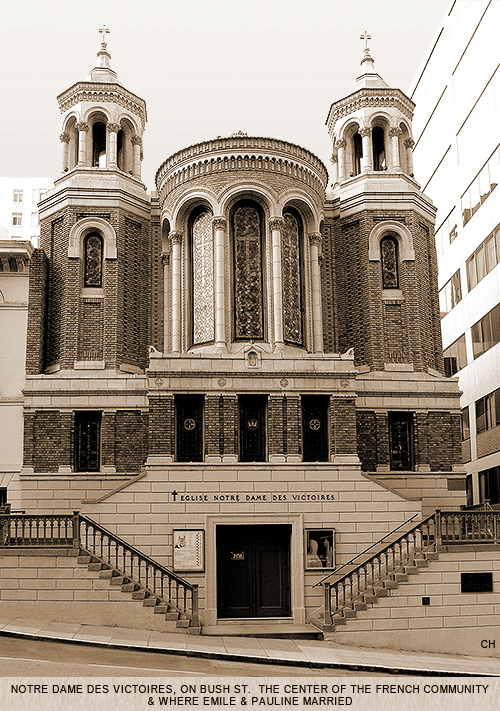
Most glowing family reports of Pauline all testify that she was beautiful. Her portraits support this. She was reported to be young, possibly under eighteen; Emile was thirty-two. Not an insurmountable handicap. She was educated in a convent; Emile was a sophisticated man of the world. This could be a difficulty. In any case the marriage was an unsuccessful one. [1884] We may follow at least the outward activities of the Penezes during these years. Emile had abandoned for the time being his interests in the theater. Early in 1884 (January), through the insistence of a friend and by encouragement and pleas of his "public", Emile consented to perform "Les Epicieres" (The Groceryboys) at a gathering. The press notice ecstatically reported the event and expressed the hope that Emile would come out of his retirement and entertain his public again. Three months later ( March 11) Emile performed "Le Carrilloneur" (The Bell ringer) and was greeted with "deafening applause". By early May, 1884, Emile was once again appearing in programs to the delight of his audiences..."Bravo, Penez." At last, on May 25, 1884, Pauline appeared at an anniversary celebration with Emile, this at the home of a Mrs. Balny. Further appearances by Emile (alone) follow through June into July. Then there is another blank; no notices. One interesting clipping a little earlier, is an advertisement which appeared in the French press March 17, 1884 which states "M. E. Penez informs his friends and the public in general that he is opening a store of wines and liquors, called The Maison Francaise, on the corner of 5th and Bryant Streets, where customers may find an assortment of wines and spirits of first quality. Wines may be purchased in gallon amount if desired." So, Emile ventured into Business: There is nothing that follows to indicate the duration of this venture. Emile remained continuously employed at the Union Iron Works as draftsman and designer. All other activities were most likely aside from his major vocation. [1885] Emile became markedly more active in French circles. His dramatic appearances became more frequent. A new interest is reflected in the notices: benefits for fraternal and patriotic societies, such as, the Knights of Pythias at Irving Hall for a Segnor Guiseppi Parenti, the National Holiday celebration for the fifty-fifth anniversary of the Independence of Belgium at Steven's Park, Oakland. Also, Emile became an active participant of La Societe Francaise de Bien Faissance Mutuelle (The French Society of Mutual Benefit). Possibly Emile was instrumental in its organization. He is named as one of the officers (second secretary) at the beginning of its second year. He worked with this group for the remainder of his time--as an officer and a faithful contributor of his efforts and talents. [1886] Now Emile shows another new activity: the Theatre Francais. On May 9th he performed in three presentations: "Les Absences de ma Femme" ( My Wife's Absences), "Entre Paris et Londres" (Between Paris and London), and "Triolet, Ou l'Entfant de Tout le Monde" (Triolet, or the Whole World's Child). Penez's performance is described as "Screamingly Funny". In November, Emile performed there in Le Feu au Convent (The fire in The Convent) with verve. There was some dismay, however, in that during the first presentation of this work it appeared that M. Penez muffed his lines: This was so unlike his usual conscientious interpretations that the press went to some length to clarify the difficulty. It was determined that the marred performance was unhappily the result of a delay in the appearance of another actor on cue, causing an awkward gap. The subsequent performances were not hampered by this mishap and the revues of Emile's work became again enthusiastic and generous in praise of his skill. ~~ 1887 ~ Divorce & Beyond~~ Thus we come to the fateful year. In January Emile embarked on another new business venture, the "Fedora" kid glove enterprise on Geary Street. The understanding is that his partner was a M. Limousin. Later that year, on March 27th, Emile Penez was elected president of the French Beneficial Society. In June performances continue, and elaborate plans are made for the celebration of Bastille Day --the French Fourth of July, which is on the fourteenth of July. In the midst of these activities appears a cold notice: "July 7, 1887. Judge Wilson divorced Pauline Penez from Emile T. Penez on the grounds of his adultery, awarding her the custody of the child and $35.00 a month alimony." What had been going on? This climax, no doubt, had been building for some time. At first that Emile was devoting his complete attention to Pauline. That for three years it appears, he cut himself off from his usual interests, that he gradually returned to these, as if reluctantly "giving up".By now it was too late, no doubt. We see him now throw himself almost feverishly into activities, almost as if to forget. This, he never really does. The divorce notice was on July 7. A week later, the celebrations of the French national holiday, July 14th, Emile outdid himself. At the Mechanics Pavilion he presented "Le Marsailles", as was customary, and then added several new numbers, among them "En Rev'nant de la Revue" (In the Spirit of Review), a highly enthusiastic national song in reference to a then controversial political figure in France - (General Earnest) Boulanger. On August 21, 1887, Emile entertained the French Lodge of I.O.O.F. Three days later a final notice appears that divorce was granted Pauline -- granted by default. Emile did not contest. Thus ended the marriage. There are many questions unresolved. One should understand that divorce "for reason of infidelity" was the customary grounds presented at that time. No-contest or default was the chivalrous answer to such charges. It is curious that there are no rumors nor are there any references to "affaires" involving Emile with any woman--not even in family gossip. It is also curious that Pauline later married a M. Limousin. (This is the name of Emile's partner in the Fedora glove business). To further confuse the picture, subsequent clippings in Emile's book show strong evidence that Emile and M. Limousin remained friends for many years to come. Finally, although Pauline had been granted custody of the child, Charles, she did not continue for long. Emile assumed responsibility for the care of their son. Consequences? Some are evident in Pauline's story and that of her son Charles. There is nothing, however, that throws light on the effect of the divorce on Emile. He kept his council. Outwardly, he carried on his life as before. Thus for Emile the year 1887 gathered momentum as it unfolded. At the great Fourteenth of July celebration Emile presented a triumphant "En Rev'nant de la Revue", which was the new rage in Paris, and had become a second rage in San Francisco, as evidenced by the interests of the French expatriates in their enthusiasm for the controversial political idol, Boulanger, and their interests in their homeland which embraced this new song. The Bastille celebration lasted through Friday and Saturday. It was originally to be held at Woodward Gardens, as was customary, but this year the affair was transferred to the Mechanics' Pavilion. The owner of Woodward's Gardens, loath to lose such lucrative business, unsuccessfully attempted to stage a rival fete at the Gardens. The consensus of opinion was that only "hoodlums" went to Woodward's Gardens; the "elite" attended the Mechanics' Pavillion. In any case, those who attended the Pavillion program were treated to six national patriotic tableaux (French), fireworks, and a ball, a march of the Lafayette Guards and another march of the French Zouaves, a symphony, and Emiles's presentation of En Rev'nant . On Saturday the celebration had begun at 7:00 in the evening. It ended at dawn, Sunday. As to "En Rev'nant", here are selected quotations from the San Francisco Examiner of July 15, 1887, written in English, of course, for the "general" public in description of the piece:
The synopsis of the lyrics does not do justice to the political and emotional tone of the time. But more to the home-sick expatriates who formed a little island of La Belle France half a world away, the occasion was bombastic. Further, the centennial of the French Republic was only two years away. Emotions were high. A grand reception was held for the Admiral "the Marquis de Bond" and for the officers and crew of the Duquesne (Duguesclin?) on November 11, Thanksgiving Day. The occasion was a brilliant opportunity for the city of San Francisco and especially for its French colony to display its most lavish hospitality. A sumptuous dinner featuring that American Bird, the turkey (600 pounds of it), apples (15 cases), raisins (30 cases), cheese, wine, and all that the city could supply in supporting embellishments was offered to the full complement of the ship's personnel and the delighted hosts -- the magic Cirque Francais. Entertainment was generous, too, with presentations of skits and songs. The ship's band played stirring music. Emile's contribution was, again, "En Rev'nant", and a poetic recital of a dramatic poem -- "L'Eqauve" (the Shipwreck), and a comic number "La Source" (about the difficulties of placing a maid in a household. The source being perhaps, the husband). ~~ 1888 ~ Busy Years~~ Two curious clippings of 1888 in Emile's book seem to reflect the turmoil of the previous year, both in reference to legal separations. One, in January, is of Adele E. Dolet from Louis E. Dolet on grounds of cruelty, with no further reference to either party in Emile's effects. The other, in June, is of Xavier Van de Casteele, who is reported as flagrantly deserting his wife, Leonie Pauline, for love of another woman (unnamed). Emile remained friends with M. Van de Casteele. Xavier is recipient of special greetings the following year while Emile was visiting in Paris. Aside from these two notices, the press references of 1888 indicate continued performances of Emile. In May he again introduced a new French song, this time "Les Pioupious d' Auvergne" (The 'Sojer' Boys of Auvergne). This presentation was greeted with enthusiastic anticipation and acclaim. "Les Pioupious" is a sequel to "En Rev'nant" which Emile had premiered the previous Bastille Day and that was so vociferously received by the French supporters of General Boulanger. The new song was a further expression of such support. Emile is credited with being the first to present this number in the United States. Its advent created quite a stir. In an announcement May 22, 1888, "M. E. Penez 'yesterday' had received a copy of 'Les Pioupious' directly from Paris, where the song was currently in great vogue, and he was to present the song 'tomorrow' evening at a benefit for M. Juignet at Irving Hall, 139 Post Street, San Francisco". Later, in July for the celebration of Bastille Day, Emile presented another highly patriotic number, Fetons le Quatorze Julliet (Celebrate the 14th of July). For this Emile received a special presentation of two bouquets from the program committee. A further little touch relevant to this occasion is the appearance of "Ch. Penez" among a list of children performing in a chorus which sang patriotic songs at this celebration. Emile had drawn an outline around the name in the clipping and had noted by hand in the margin "mon fils", my son. ~~ (1) ~~ UNION IRON WORKS & THE LAUNCHING OF THE CHARLSTON ~~ (First of Three sections of this biography cover Emile's career as a ship designer & activities at the Union Iron Works) Online Photos of the Union Iron Works & Ships mentioned in Emile's career» At The Union Iron Works, Emile was employed primarily as designer-draftsman. This was the chief steel and iron manufacturer on the Pacific Coast. Shortly after these festivities (from the above section) followed another great day, the launching of the U. S. Cruiser Charleston from the Union Iron Works shipyard on July 19, an Ironclad Warship. For this important occasion Emile wrote an account of its launching for the Franco-Californien, the major French newspaper for northern California. Here is a paraphrase of his article:
|
|||||
Further activities of the year 1888 show with what variety of interests Emile was concerned. As secretary of the French Benevolent Society, Emile wrote an indignant letter to the Franco-Californien concerning the treatment afforded a M. Limousin in emergency at the French Hospital. As gourmet, Emile attended a banquet at Delmonico's Restaurant for the international Society of Chefs and there he graciously responded to a request to recite "Aux Alsaciens-Lorrains" ! As devotee of the theater, Emile answered a most flattering request from the director of the Franco-Californien that re review for that newspaper the Comide Francais production of Molier's works, which was then in progress. This was an event in which the French Colony in San Francisco took considerable pride. The request was modestly fulfilled, not as a critic of classical theater, but in admiration and full appreciation of this accomplishment of the Theatre Francais in this far western city. As an officer Emile served as Suillant (assistant) in the fraternal organization the I.O.O.F. Thus the year came to an end and bridged into 1889. This was to be a glorious year for Emile, graced by two major events: a pilgrimage to France to celebrate the one hundredth anniversary of the Fall of the Bastille by attending the Paris Exposition and, later, the launching of the San Francisco - United States Cruiser, sister ship to the Monterey. ~~ OFF TO PARIS AND THE OPENING OF THE EIFFEL TOWER ~~ It is easy to imagine the excitement Emile must have felt in planning and preparing for this one voyage back to France. It had been fourteen years since he had journeyed to America, twelve years since he had settled in San Francisco. He was now thirty-nine years old, had been married and divorced. Included in his plans for the trip was his son Charles. Charles, though only six years old, always remembered this magic excursion with his father as one of the highlights of his childhood. On the third of April Emile and Charles left San Francisco for New York, presumably by railroad across the continent, where they boarded the S.S. Obdam for Rotterdam on April 13, 1889. Emile Penez and Master Charles Penez are listed among the passengers, the only passengers from San Francisco, California. It is likely that Emile and Charles visited the Penez family in Belgium. Emile's temporary mailing address while he was in Europe was in the care of Ernest Rigaux, St-Ghislain, Belgique, Beauchais Victorien. One enchanting feature of the Eiffel Tower was the incorporation at its greatest height of a post office from which letters and post cards could be sent to all parts of the world. Of this Emile took full advantage, using its service to greet his friends "the absent Californians". With great ceremony on the Fourteenth of July, 1889, Emile and Charles dropped post cards to San Francisco, one of which was in verse and was reproduced in Figaro (a French newspaper in San Francisco). It read as follows:
I don't know of he persons named, but the message is simple, that these friends shall receive from the top of the Tower Eiffel a letter of greeting and a description of the monuments that he and Charles could view from on high. A letter box has been installed on the third level of' the Eiffel Tower from which collections are made twice daily. The post cards, usually less, are priced at three cents as a symbol that they are posted from the third or highest platform. A table is placed in the center of the platform for use in writing letters. This original idea has proved a great success as it provides the provincials this opportunity to prove to their compatriots that they have ascended to the very top of the Eiffel Tower; it is said as well that from here many farewell embraces are delivered and that rivals of Tartarin (a French folk figure) cry out from here at the top of their lungs, "I am writing to you from the top of the Tower," Upon his return to San Francisco, Emile was interviewed by the Franco-Californien to share with the stay-at-home San Franciscans his impression of the controversial "Egyptian" dance that he had witnessed while he was at the Exposition. Here is a synopsis and some excerpts from the article:
Emile and Charles had returned to San Francisco in late September. ~~ (2) ~~ MORE ACTIVITIES AT THE UNION IRONWORKS ~~ Almost immediately Emile was busy at the Union Iron Works in preparation of the launching of the United States Cruiser San Francisco. Again Emile, as Draftsman-Designer in the Bureau of Studies at the Union Iron Works, wrote a description for the Franco-Californien October 27, 1889. Paraphrase:
More of the Union IronWorks following this next segment. . . Online Photos of the Union Iron Works & Ships mentioned » ~~ ENTERTAINMENT ~~ The year 1889 closed with a brilliant ball on December 14th at Odd Fellows Hall for the Spanish Mutual Benevolent Society. The hall was lavishly decorated with the gold and scarlet of the Spanish flags as well as the red, white, and blue of those of the United States. Garlands of smilax hung from every chandelier. Entertainment for the evening included the introduction by Emi!e of another popular song, the latest "rage" in Paris: Le Pere de la Victoire (the Father of Victory). Emile was accompanied by his life-long friend, Professor Louis Raynaud. (this identifies one of the names in Emile's greeting verse sent to San Francisco from the Eiffel Tower!) The presentation of the new song was delivered spiritedly, "with taste and ability." ~~ 1890 --1900~~ The new year, 1900, the new decade, "the gay nineties", opens with a report of a case of "La Grippe" (Influenza), an amusing verse written by Emi!e of the miseries of this affliction. He apparently recovered forthright, as he entered a veritable siege of social and fraternal activities. Here are mirrored the interests of the French colony of San Francisco in general and the concerns of Emile in particular. Here is a partial list of events and accounts from Emile's Book of Clippings. Many of the songs were so popular that the full text was printed in the local papers and Emile's skill 1n presentation is still reported with enthusiasm. He still "convulses his audiences with laughter".
An annual fete was held, this time,for the French Benevolent Society at Odd Fellows Hall. Songs presented: Le Pere de la Victoire, again and Le Chene et Le Roseau (The Oak and The Reed, a bit spicy")" A Soiree -- Grand Ball, "Frisette et Briochette" (side-splitting). A new society "La Gauloiae" presented "Fortunia". The Culinary Society recited "Le Coup de Tampon" (a long poem by Francois Coppee). The grand concert and ball, benefit for Louise Grosset at Odd Fellows Hall -- La Valse des Pruneaux (The Waltz of The Plums) and La Pipe du Comandant. One event is omitted in the reports for the year: 1890 -- the 14th of July. It must have been an oversight. Emile was too much immersed in celebrations of the Gallic spirit to have missed so great an event! The years that follow carry the same momentum. March 1901 presents a grand concert in Irving Hall, a benefit for the artists this time. Emile sang two new songs: La Terre (The Earth) and Le Cheval du Municipal (The City's Steed). In April, a farewell for M. Albert Guille at Odd Fellows Hall. Emile presented La Terre and La Lune (The Moon) and, further, presented another long poem by Francois Coppee -- entitled Mere Nourrice (Mother Nurse). The list of presentations seems endless as the years mount. This is a good place to pause and examine other facets of Emile's life and interests. ~~ (3) ~~ MORE AT THE UNION IRON WORKS ~~
At this time, the early 90's, the company employed over two thousand workers, later became a branch of Bethlehem Steel Corporation and even later, Todd Shipyards. Through the many festive notices in Emile's scrap book clippings shine reflections of his enthusiasm and pride in this occupation. His personal contributions to the success of the business were as varied and complex as his own personality. At first it was probably expedient that the Union Iron Works would call upon Emile to host visitors, primarily French visitors, who came to view the works. It is almost certain that Emile's skill in English was satisfactory. Perhaps he spoke the language with a strong accent. However, his forte was French. He never, as far as the clippings and reviews show, made any public presentations, oral or written, in any other language. It was noted at one fete or grand dinner for the co-workers of the Union Iron Works that he presented some of his delightful comic songs, which were not truly understood since "they were presented in French" but were "much appreciated by his audience". And so it developed over the years that frequently Emile was called upon to show visitors through the works. The ironclad ship section was the most popular. The first group of visitors thus entertained according to the record available was the officers of the visiting French ship the Duquesne in 1881, as reported above. Great pride of accomplishment is reflected in the accounts of the launchings of the great ships that this sturdy little company produced. I have already reported above of the festivities for the launching of Le Charleston in 1888, Le san Francisco in 1889. Then in 1891 was the launching of The Monterey.
This little contribution of Emile's talent became in time an important part of the tradition of launchings, especially in the launching of steel battleships for the United States Navy. There were a number that followed, among which were: The Olympia in 1894 The Oregon in 1896, The Farragut in 1898, The Ohio in 1901. Emile 's design for the launching plaque remained similar; the sentiment and memento was usually presented to the lady who "pressed the ivory button and released the bottle of California champagne." For the baptism of The Ohio President and Mrs. Mc Kinley were present. The plaques were taken back to Washington, D.C., with the honored guests. There were other activities that Emile happily performed aside from his regular duties as draftsman. He composed newspaper articles of works in progress for the French newspapers of San Francisco. He had his hand in preparation and planning of banquets, entertainments, and honors for the owners and officers of the establishment -- Irving Scott (general director), Henry T. Scott, and John Scott. And he helped prepare drawings, engineering details, paintings, graphs, and charts of the iron-clads for display and information to the general public. One such exhibition was held at the Mechanic's Institute in 1899 for over 4,000 visitors. |
|||||
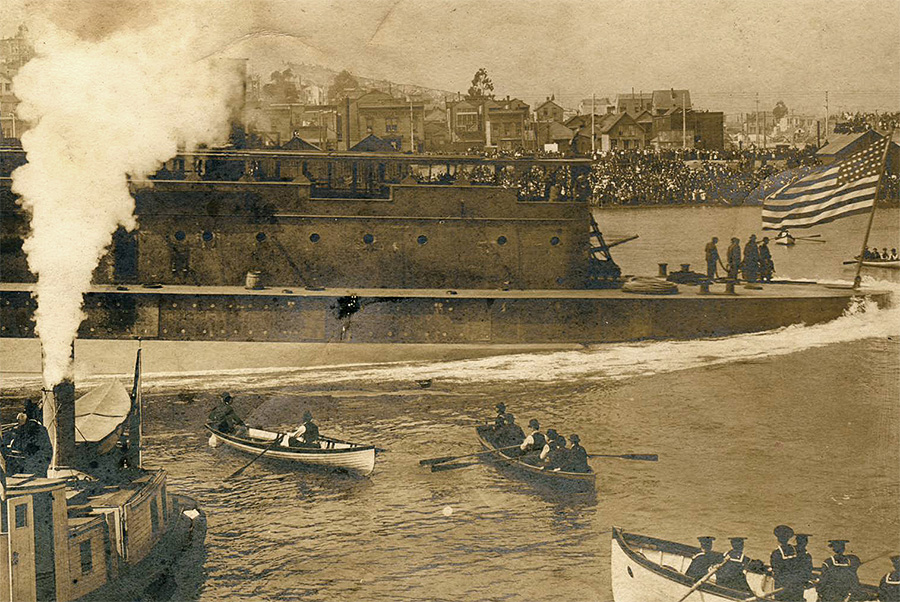 Iron-Clad Ship Launching at Union Iron Works 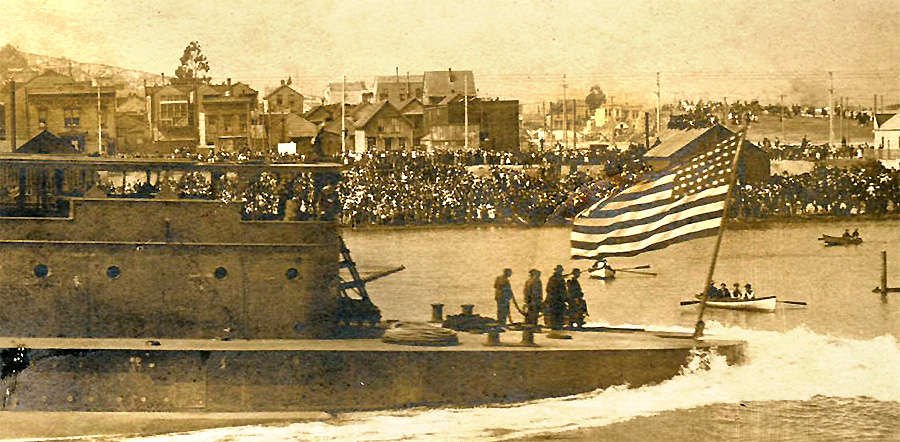 Close-Up with Crowd & City Details Other Images on Union Iron Works & Ships from Online Sources » |
|||||
 Plaque for Launching of USS Ohio, with President McKinley, newspaper photo below: 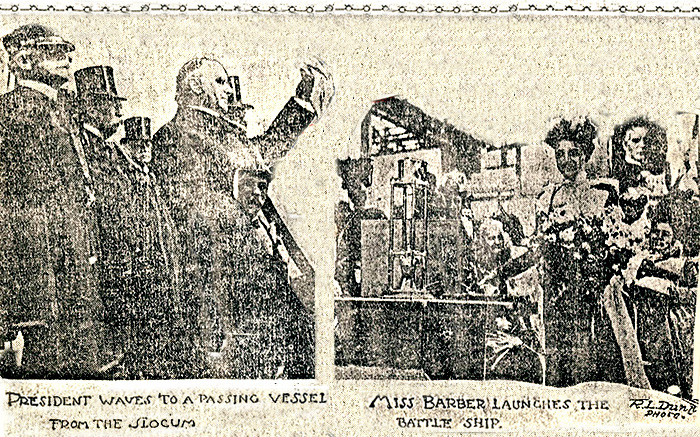 President McKinley presides over the launching of The Ohio & Later Image: 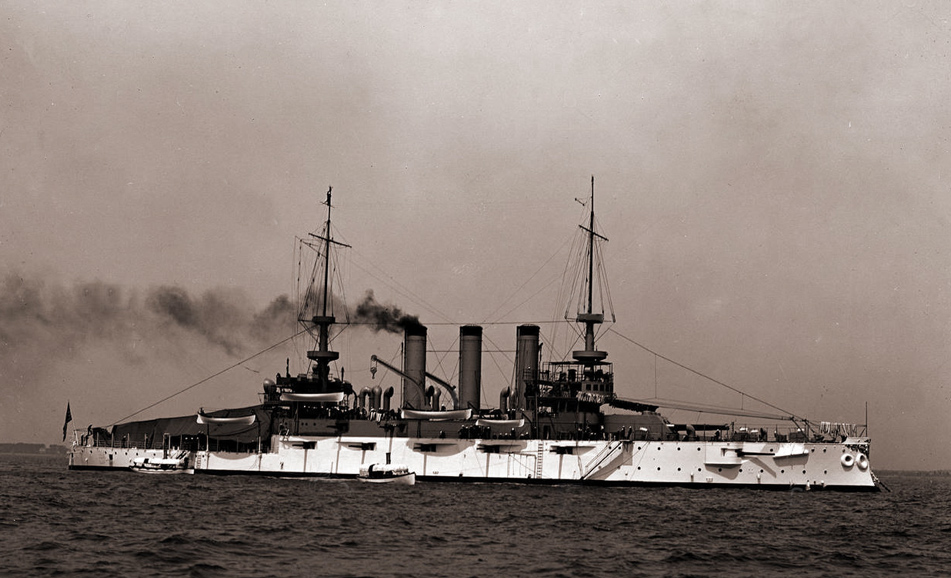 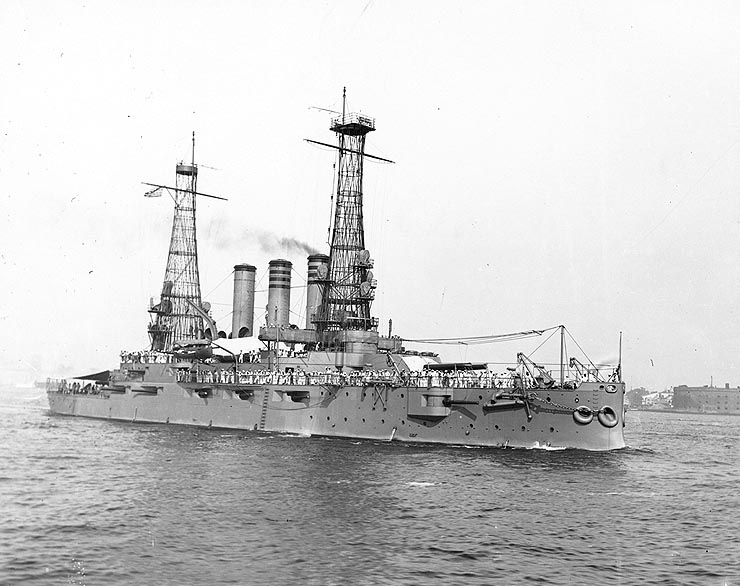 Stereo View » |
|||||
|
|||||
|
 present of:
(1) Emile's album of press clippings, many from San Francisco newspapers; (2) his paintings; (3) photographs -- copies of the originals in the Penez family album, and; (4) such data as I have been able to gather from such sources as the United States census records, the San Francisco Directory, et al.
present of:
(1) Emile's album of press clippings, many from San Francisco newspapers; (2) his paintings; (3) photographs -- copies of the originals in the Penez family album, and; (4) such data as I have been able to gather from such sources as the United States census records, the San Francisco Directory, et al. 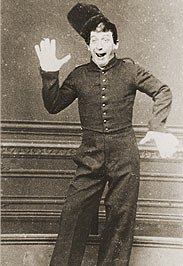 From early photographs taken in Brussels we first see Emile as a student of eighteen. Next he appears as a soldier, off to the Franco-Prussian War of 1870. The war was disastrous to Belgium and France. By 1871 Emile was back in Brussels. His next portrait suggests that the year of war had matured him somewhat. At least he appears more relaxed, as if he had gained a measure of self-assurance which is lacking in his earlier photograph.
From early photographs taken in Brussels we first see Emile as a student of eighteen. Next he appears as a soldier, off to the Franco-Prussian War of 1870. The war was disastrous to Belgium and France. By 1871 Emile was back in Brussels. His next portrait suggests that the year of war had matured him somewhat. At least he appears more relaxed, as if he had gained a measure of self-assurance which is lacking in his earlier photograph. 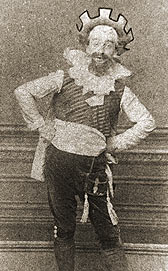
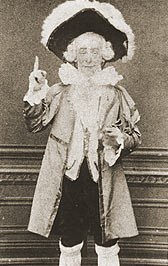 Santiago, Chile. Supposedly a "patron" advanced the fare for this trip.
Santiago, Chile. Supposedly a "patron" advanced the fare for this trip. 
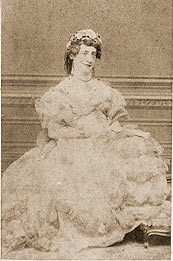
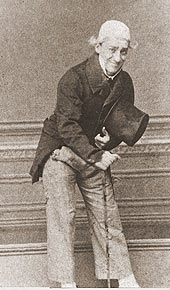

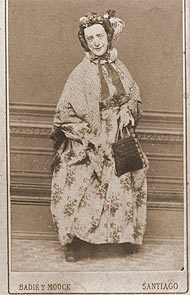

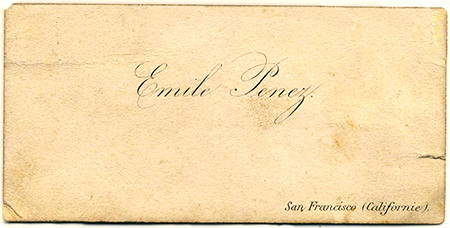
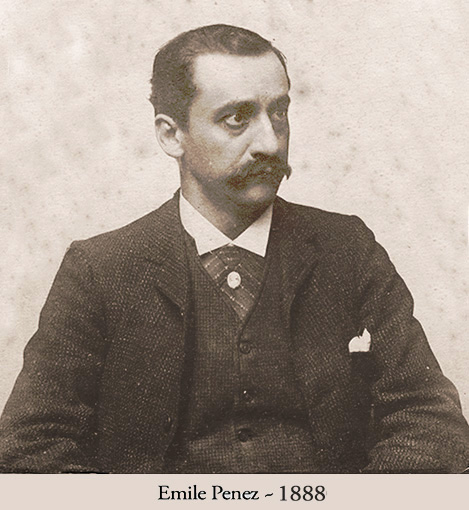
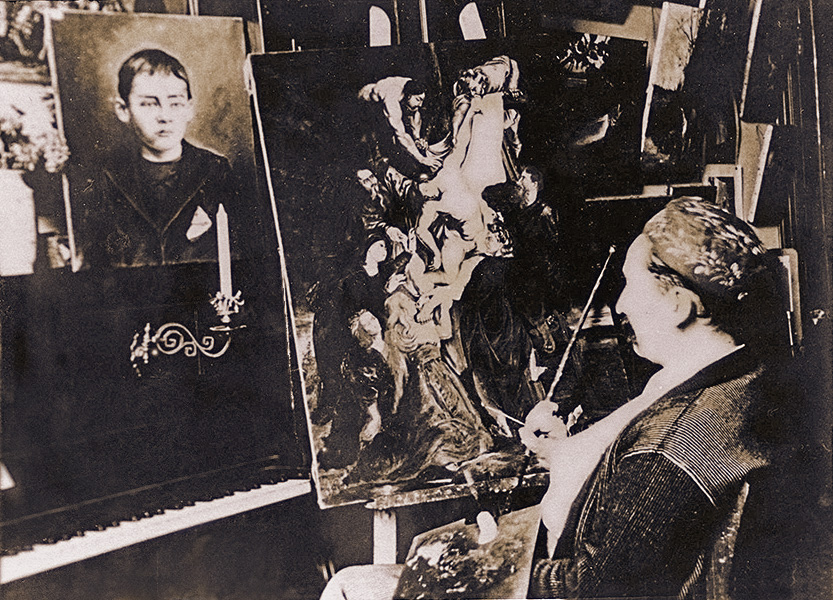 He did, and the presentation was received with gusto. The words and music of the number were reported in the newspapers as well as a synopsis and an analysis of the work. The piece itself is of very little literary value, being in the words of an infantry regiment, but the music was forceful and extremely patriotic, to say nothing of its being almost hysterical in its comic and political spirit.
He did, and the presentation was received with gusto. The words and music of the number were reported in the newspapers as well as a synopsis and an analysis of the work. The piece itself is of very little literary value, being in the words of an infantry regiment, but the music was forceful and extremely patriotic, to say nothing of its being almost hysterical in its comic and political spirit. 
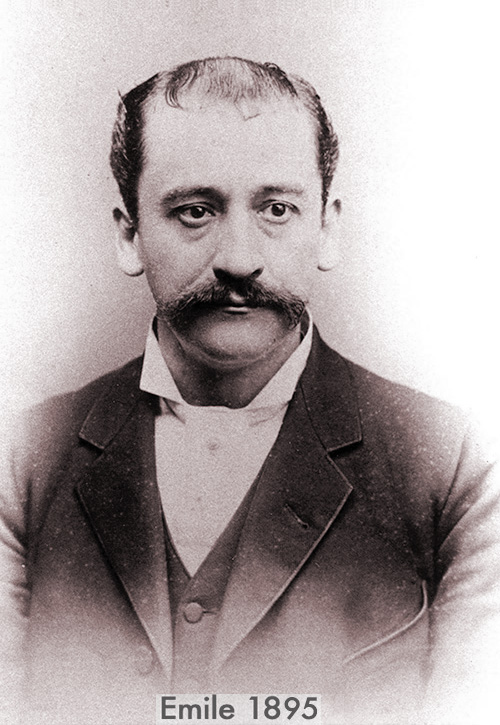 tc.
It has been a year since the United States Government commissioned two cruisers to be constructed in California: first, the No 2, Charleston, then the No 5, San Francisco.
tc.
It has been a year since the United States Government commissioned two cruisers to be constructed in California: first, the No 2, Charleston, then the No 5, San Francisco. 
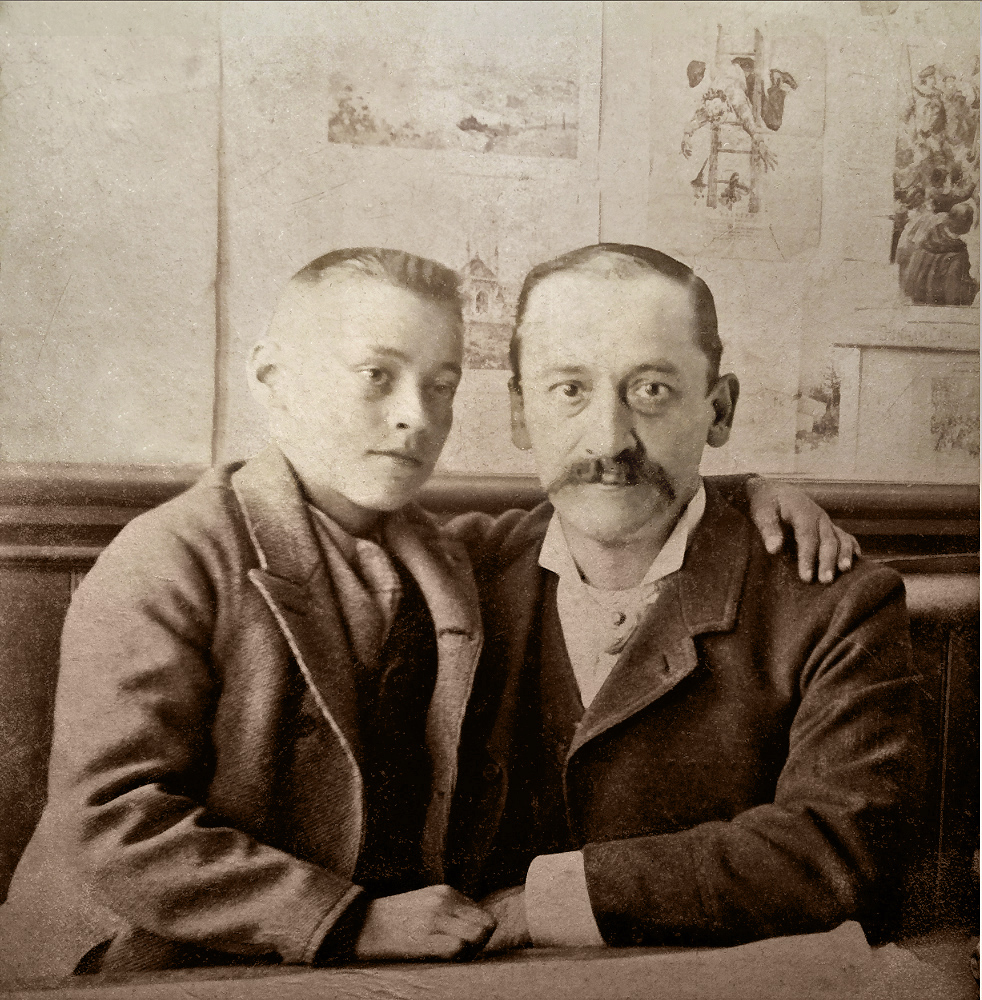

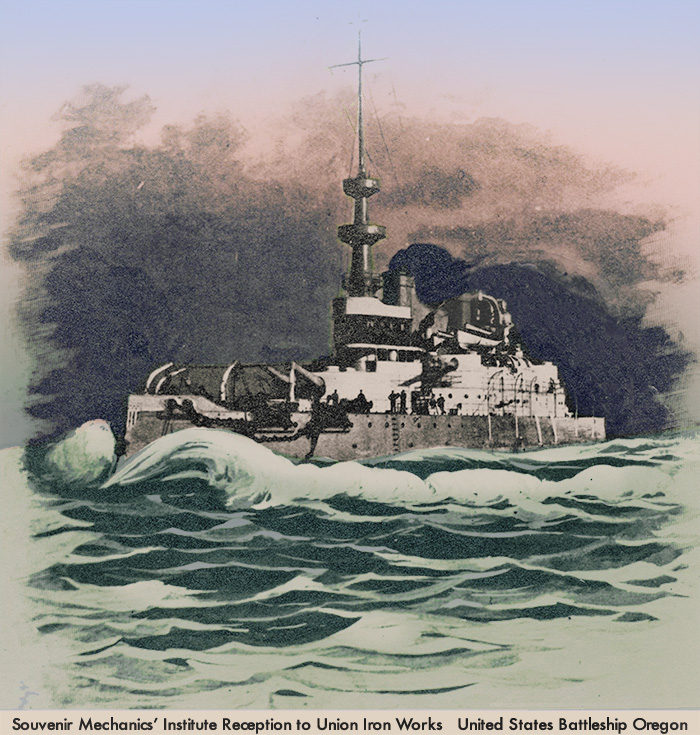
 This was not the only ship. The Champlain came through the Golden Gate in 1890, the ~gual-Trouin in 1894, the Protet in 1900, and again in 1902. There were other visiting dignitaries, too, such as a M. Deschanel from France who was doing a comparative research study on the workingman's situation in America compared with the situation in Europe. (The report presented glowing advantages discerned for those employed at the Union Iron Works). There was also Prince Roland Bonaparte who, while passing through San Francisco, made it a point to inspect the iron-clad war vessels that were being turned out by that progressive organization. The duty of hosting with grace and dignity must have been satisfactory as performed by Emile Penez; he was called upon to fill this duty over and over again.
This was not the only ship. The Champlain came through the Golden Gate in 1890, the ~gual-Trouin in 1894, the Protet in 1900, and again in 1902. There were other visiting dignitaries, too, such as a M. Deschanel from France who was doing a comparative research study on the workingman's situation in America compared with the situation in Europe. (The report presented glowing advantages discerned for those employed at the Union Iron Works). There was also Prince Roland Bonaparte who, while passing through San Francisco, made it a point to inspect the iron-clad war vessels that were being turned out by that progressive organization. The duty of hosting with grace and dignity must have been satisfactory as performed by Emile Penez; he was called upon to fill this duty over and over again. 